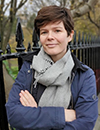Co-Located Conference AgendasCirculating Biomarkers and Extracellular Vesicles Europe 2023 | Lab-on-a-Chip and Microfluidics Europe 2023 | Organoids and Spheroids Europe 2023 | Point-of-Care, Biosensors and Rapid Diagnostics Europe 2023 | 

Monday, 19 June 202308:00 | Conference Registration, Materials Pick-Up, Coffee and Tea | |
Session Title: Conference Opening Plenary Session |
| | |
Venue: Rotterdam Room -- Hilton Rotterdam |
| | 08:55 |  | Conference Chair Welcome and Introduction by Conference Chairperson
Claudia Gärtner, CEO, microfluidic ChipShop GmbH, Germany
|
| 09:00 |  | Keynote Presentation Digital Manufacturing of Functional Microfluidic Systems: Autonomous Capillaric Circuit
David Juncker, Professor and Chair, McGill University, Canada
The culmination of digital manufacturing is the seamless manufacture of a functional device from a digital design. Additive manufacturing is now used for making microfluidic chips, but microfluidics digital manufacturing is lagging, notably because functional systems depend on proprietary peripherals and a computer, and rely on generic, mass manufactured chips. Here I will discuss capillaric circuits (CCs) which are capillary-driven microfluidics that structurally encode simple algorithms of flow events into the circuit microarchitecture, and illustrate how application-specific CCs can be 3D printed using common, widely available stereolithography 3D printers. By encoding so-called microfluidic chain reactions, CCs can be programmed to execute step-by-step hundreds of sequential fluidic operations powered by a paper only, without electricity of peripheral connections. CCs have notably been used for automating an ELISA-on-a-chip for COVID19 antibody and antigen assays, and for the first microfluidic thrombin generation assay. Thanks to a new hydrophilic resin formulation, it is now possible to download a CC design, 3D-print it – which we demonstrate using ultra low-cost (US$300) LCD printers – clean it and use it within 30 minutes. These advances open the door for distributed and digital manufacturing of functional microfluidic CCs and systems by anyone, anywhere, anytime. |
| 09:30 |  | Keynote Presentation 3D Printing of Porous Membrane Integrated Devices
Rosanne Guijt, Professor, Deakin University, Australia
The integration of chemical functionalities in microfluidic devices is mostly accompanied by the combination of different materials. 3D printing has readily been proposed as manufacturing alternative for traditional approaches, in particular for small scale production. In particular in resin-based printers, however, the combination of different materials remains a challenge. This presentation focuses on the development of resins for digital light projection 3D printing of porous materials, and their integration into fluidic devices by resin exchange and using greyscale masks. Applications of the devices include phase separation, chemotaxis, electroextraction of DNA and the detection of iron from soil. |
| 10:00 |  | Keynote Presentation Advances in Microfluidic CTC Assays and Their Application to Patient Management
Lorena Diéguez, Leader of the Medical Devices Research Group, INL- International Iberian Nanotechnology Laboratory, Portugal
Circulating Tumor Cells (CTCs) are the holy grail of liquid biopsy biomarkers in oncology, however they are very rare, difficult to isolate and have not yet demonstrated clinical utility. Microfluidics has demonstrated numerous advantages for CTC isolation and characterization, with increased sensitivity and throughput, enabling their implementation in clinical routine. In this talk, we present our most recent work for the development of robust CTC assays, and their application in several clinical scenarios. |
| 10:30 | Morning Coffee Break and Networking in the Exhibit Hall | 11:15 |  | Keynote Presentation Liquid Biopsy Follow-Up of Cancer Patients
Valérie Taly, CNRS Research Director, Professor and Group leader Translational Research and Microfluidics, Université Paris Cité, France
Technological developments; such as ddPCR or optimized NGS, have greatly facilitated the tracking of circulating cell-free nucleic acids in body effluents. Several strategies can be designed to detect and characterize circulating tumor DNA (ctDNA) using ddPCR. Examples of such strategies will be presented that are based either cancer-specific methylation markers or DNA integrity evaluation. We will then illustrate the pertinence of these approaches for the detection and monitoring of ctDNA in plasma (so-called liquid biopsy) of patients with localized or advanced cancers. Results of several prospective clinical studies will be presented. |
| 11:45 |  | Keynote Presentation In-Plane Nanopore Sensors made in by Injection Molding for Detecting and Identifying Single Molecules via Resistive Pulse Sensing
Steve Soper, Foundation Distinguished Professor, Director, Center of BioModular Multi-Scale System for Precision Medicine, The University of Kansas, United States of America
Nanofluidic devices offer promising and highly innovative approaches for analyzing single molecules and obtaining biophysical information that cannot be realized using microfluidics due to scaling issues. The ability to provide reliable, rapid, quantitative, and low-cost identification of single molecules will offer exciting new opportunities for a broad range of biomedical applications. We are developing dual in-plane nanopore sensors in plastics for the label-free detection and identification of single molecules. The hypothesis behind our nanopore sensor is, “individual molecules moving electrokinetically through a 2D nanotube will experience a time-of-flight (ToF) that are dependent upon their molecular identity.” In this presentation we will discuss the high rate manufacturing of a nanopore sensor with sub-5 nm in-plane nanopores using nano-injection molding from a cyclic olefin polymer (COP) plastic. The in-plane pores are situated at either end of a nanochannel (50 x 50 nm; 5 µm long) that generate current transient signals to detect and deduce the identity of the single molecule. The ToF is dependent on the apparent electrophoretic mobility of the molecule. The identity is determined from the ToF, the current transient amplitudes, and dwell times using multi-parameter Principle Component Analysis (PCA). We will show the ability to detect (detection efficiency ~100%) single ribonucleotide and deoxynucleotide monophosphates with identification accuracies exceeding 98%. Integrating the in-plane nanopore sensor with a solid-state nanoreactor results in a nanofluidic device that can be configured to provide molecular information from unamplified DNA/RNA targets with unprecedented capabilities. This will transform single-molecule processing to allow servicing a broad biomedical community for a wide range of applications, for example single-molecule sequencing. |
| 12:15 |  | Keynote Presentation Acoustic Trapping Mediated High-Throughput (0.5 ml/min) Isolation of Extracellular Vesicles
Thomas Laurell, Professor, Department of Biomedical Engineering, Lund University, Sweden
Rapid and clinical scale isolation of extracellular vesicles (EV) from biofluids remains a major bottle neck in EV biomarker screening studies. Microfluidics has over the past years demonstrated several potential principles for EV isolation, however commonly suffering from limited capacity and/or sample throughput. In this perspective, acoustic nanoparticle trapping has emerged as an option for EV enrichment from biofluids where acoustic sound scattering, between microbeads and extra cellular vesicles, enrich EVs onto microbeads in a stationary cluster that is retained by the local acoustic field gradient. The technique has been used in investigations of EVs in blood plasma and urine. Traditionally this has been performed at a sample flow rate of ˜ 20 uL/min in a half wavelength acoustic standing wave trap, localized in a glass capillary, which when processing larger samples volumes, for increased biomarker sensitivity or when enriching EVs from dilute biofluids such as urine, suffer from extended processing times. To overcome this limitation we have developed an acoustic trapping unit, with ten standing wave nodes, that offers up to 40X increased trapping capacity and 25-40X increased sample processing flow rate. A typical sample flow rate of 500 uL/min enables rapid EV isolation and washing of milliliter volumes of urine as well as blood plasma in minutes prior to MS proteomic analysis. The proteome analysis of the acoustically enriched EV fraction displays clustering of proteins at elevated levels as compared to the input sample, suggesting a sub proteome specifically linked to the EVs. Furthermore, studies on EVs derived from pathogen activated platelets will be presented. |
| 12:45 | Networking Luncheon in the Exhibit Hall -- Network with the Exhibitors and View Posters | |
Session Title: Emerging Themes in Lab-on-a-Chip/Microfluidics and Companies in the Lab-on-a-Chip/Microfluidics Space |
| | |
Session Chairperson: Dr. Claudia Gärtner, CEO, microfluidic ChipShop |
| | |
Venue: Rotterdam Room -- Hilton Rotterdam |
| | 14:00 |  | Keynote Presentation Resolving the Pre-Analytical Gap: Blood Handling and Processing in Microfluidic Format
Maiwenn Kersaudy-Kerhoas, Professor of Microfluidic Engineering, Heriot-Watt University, United Kingdom
Pre-analytics, or the manipulation and transformation of raw samples prior to their analysis, remains an important challenge for point-of-care devices. Demonstrating new sensing modalities on raw, rather than contrived samples, is sometimes considered as the ‘last frontier’. If done improperly, the pre-analytical phase can impact the quality of the sample analysis, and lead to diagnostic errors. This presentation will detail the design, production and use of simple, robust and modular devices for venous and capillary blood handling (covering blood transportation and metering, blood lysis, plasma separation and cell-free nucleic extraction) in microfluidic format. Our typical starting sample volume range spans from a few microliters to several milliliters and our devices have applications in point-of-care liquid biopsy workflows, from prenatal testing, drug-induced liver injury, and infectious disease diagnostic. |
| 14:30 |  Enabling Sepsis Tests: Nano Precision for Microfluidics Enabling Sepsis Tests: Nano Precision for Microfluidics
Iris Prinz, Head of Sales and Business Development, STRATEC Consumables GmbH
When starting a microfluidic project, many specifications are unknown and we as manufacturer challenge our customers a lot: Which specifications derived from the application requirements need to be met and controlled within certain tolerances in production? Not only but especially for applications requiring nanometer precision, it is of high importance to control the manufacturing processes like molding and bonding, but also set up proper characterization techniques to ensure continuous quality. We will show the realization and implementation using the example of Cytovale’s IntelliSep® chip having the need of microfluidic channels with nanometer precision for Sepsis Diagnostics.
| 15:00 |  Where Photonics meet Microfluidics – Consumables for Life Sciences in Glass Where Photonics meet Microfluidics – Consumables for Life Sciences in Glass
Tobias Bauert, Business Development Manager, IMT Microtechnologies
Fluid manipulation on the micro-scale allows new applications in various fields including life sciences and diagnostics. Glass sometimes is the only applicable material due to limiting optical specifications or very harsh operating conditions. By harvesting the power of CMOS manufacturing technologies with non-CMOS compatible materials on glass, cost effective consumables for life sciences become reality in all volumes from prototyping to large scale manufacturing. At the overlap of semiconductor manufacturing technologies and microfluidics a multitude of added functionality can be incorporated into glass chips, enabling a new class of consumables for life sciences and diagnostic applications.
| 15:30 |  How to Choose the Right Chemical Formulations for Microfluidic Applications? How to Choose the Right Chemical Formulations for Microfluidic Applications?
Segolene Antoine, Scientific Account Manager, Emulseo
Droplet-based microfluidics has emerged as an efficient solution for
rapid, precise, quantitative and low-cost screening tool for biological
and chemical applications. The monodisperse water-in-oil droplets
generated in droplet-based microfluidic devices are loaded with
biological or chemical agents. The droplets are used as
microcompartments. To analyze and/or sort the content of the droplets,
dyes are usually added. The droplets are then monitored and sorted
according to their fluorescence signal. A common issue in droplet-based
microfluidic experiments involving the use of dyes is dye leakage. The
release of the dye into the oil phase and neighboring droplets results
in a decrease of the accuracy of fluorescence monitoring. Some of the
parameters influencing the retention of dyes in droplets are the nature
of the buffer or cell culture medium, the choice of fluorophore and its
hydrophilicity, the oil phase and the concentration, nature and
molecular weight of the surfactant. In this presentation, we will first
present a comprehensive investigation of the impact of oil choice and
surfactant concentration on dye leakage during droplet-based
microfluidic experiments. The performance of two fluorinated oils and
surfactant concentrations on dye retention will be discussed. Secondly,
the impact on the results resolution of the surfactant auto-fluorescence
will be discussed.
| 16:00 |  3D Printing: Realizations in Microfluidics and Biomedical with Dilase 3D 3D Printing: Realizations in Microfluidics and Biomedical with Dilase 3D
Paul Coudray, CEO, Kloé SAS
We are pleased to present Dilase 3D, a 3D printer by SLA which combines high resolution and capability to build large size objects in reasonable writing times.
| 16:30 |  | Keynote Presentation Modular Design of 3D Printed Microfluidics for Bioprocess Applications
Noah Malmstadt, Professor, Mork Family Dept. of Chemical Engineering & Materials Science, University of Southern California, United States of America
As 3D printing replaces traditional clean room manufacturing for microfluidic engineering applications, it’s becoming clear that this transition offers not only lower cost and faster design iterations, but also new opportunities for fluidic routing and control that are only possible due to the inherent three-dimensional nature of these systems. Over the past several years, we have developed design principles that take advantage of this three-dimensionality, as well as demonstrating several applications that benefit from this approach. At the core of these design principles is the modularity of microfluidic unit operations. In addition to designing prototypical unit operations such as mixers, splitters, flow focusers, droplet generators, thermal and optical sensors, and world-to-chip interfaces, we have developed systematic approaches to combining these modules into microfluidic circuits with predictable behaviors. This approach can be used to rapidly prototype complex microfludic operations by assembling physically distinct modules as well as to design monolithic microfluidic devices which can be printed in a single run. We have demonstrated the power of this approach by building several micro- and milifluidic systems for bio-analysis and bioprocess applications. These include systems for biomarker diagnostics, automated high-throughput affinity screening, and rapid manufacturing of vaccine lipid nanoparticles. We have also demonstrated how entire systems can be treated as modules, allowing for scaling of bioprocess production lines by massive parallelization. |
| 17:00 | High-Resolution 3D Printing within Microfluidic Chips
Aleksandr Ovsianikov, Professor, Head of Research Group 3D Printing and Biofabrication, Technische Universität Wien (TU Wien), Austria
| 17:30 | Advanced Signal Processing for Optofluidic Single-Molecule Sensors
Holger Schmidt, Narinder Kapany Professor of Electrical Engineering, University of California-Santa Cruz, United States of America
Chip-scale optofluidic devices have emerged as powerful, ultrasensitive sensors for molecular biomarkers. Maintaining outstanding performance in a point-of-care setting introduces new tradeoffs between cost, reliability, and performance. I will discuss the use of advanced signal processing methods that provide optimized information extraction in the presence of limited signal-to-noise ratios that are typically found outside a research lab. Examples include a new, ultrafast wavelet-based signal analysis algorithm, the use of machine learning and neural networks for multiplexing, and a new modulation technique that provides ultrawide dynamic range with a single method. In concert, these techniques allow for real-time, single molecule detection at the edge. | 18:00 |  Advanced Methods for the Production of Next Generation Flow Reactors Out of Glass Advanced Methods for the Production of Next Generation Flow Reactors Out of Glass
Klaus Kadel, Business Development, Little Things Factory GmbH
The Little Things Factory covers the whole portfolio to set up new functionalities for microfluidic systems in glass and we describe recent innovations in this field. The talk will introduce new possibilities to produce PLGA nanoparticles using flow reactors with high throughput and new flow reactors with catalysts in flow.
| 18:30 | Networking Reception with Dutch Beer and French Wine Tasting Sponsored by Kloé: Engage and Network with Colleagues, Engage with Exhibitors and View Posters | 19:30 | Close of Day 1 Conference Programming |
Tuesday, 20 June 202308:00 | Morning Coffee, Tea and Networking in the Exhibit Hall | |
For Morning Conference Programme Details, Please Visit the Organoids and Spheroids Agenda |
| | 12:30 | Networking Luncheon in the Exhibit Hall -- Network with the Exhibitors and Engage with Colleagues | |
Biotechnology in Space: New Opportunities for Superior R&D -- Session Sponsored by ICE CUBES -- Session Duration 13:30-14:30 | Session Sponsors |
| | |
Venue: Rotterdam Room -- Hilton Rotterdam |
| | 13:30 | Biotechnology in Space: New Opportunities for Superior R&D
What are the benefits of biotechnology research in microgravity? Join our panel of experts as they delve into the latest case studies and opportunities in the field, including biofabrication in space, heart-on-a-chip research, patient-derived Organoids, and microfluidic bioreactors. Explore how these innovations hold potential for improving human health, transforming industries, and shaping the future of scientific exploration. Space is more accessible and affordable than ever, and sectors like biotech are benefiting greatly from this development.
Panel Discussion Moderator: Jose Salgado, Space Commerce Matters
Panelists:
Dr. Hilde Stenuit, ICE Cubes by Space Applications Services. Title: “Why Space for Biotechnology?”
Prof. Dr. Lorenzo Moroni, MERLN Institute for Technology-Inspired Regenerative Medicine. Title: “Biofabrication in Space”
Dr. Eng. Kevin Tabury, Belgian Nuclear Research Centre. Title: “Heart-on-a-Chip Research in Space”
Dr. Sylvia Boj, HUB Organoids. Title: “How Space Research provides unique opportunities for Biomedical Research with patient-derived Organoids”
Simon Werner, M.Sc., NMI Natural and Medical Sciences Institute at the University of Tübingen, Organ-on-Chip Group. Title: “Towards Microfluidic Bioreactors For Space Applications” | |
Session Title: Lab-on-a-Chip and Microfluidics: Technologies, Tools and Applications -- Session Starts at 14:30 |
| | |
Session Chairperson: Dr. Claudia Gärtner, CEO, microfluidic ChipShop |
| | |
Venue: Rotterdam Room -- Hilton Rotterdam |
| | 14:30 | Versatile, Material-Independent Chemistries for Surface Properties Tailoring and (bio) Functionalization of Microfluidic Devices
George Tsekenis, Head of Applied Biophysics and Surface Science Laboratory, Biomedical Research Foundation of the Academy of Athens, Greece
Microfluidics have recently garnered considerable interest due to their unique benefits over conventional liquid handling systems and the tools they provide towards the development of lab-on-a-chip devices and organ-on-a-chip systems. Irrespectively of the specific application, the surface properties of microfluidic channels have to be carefully engineered to render them biocompatible and/or antifouling, customize their wettability or provide anchoring points for biomolecule tethering. Despite the significant progress made, surface (bio) functionalization remains a hard-to-navigate step in the fabrication process of microfluidics-based devices, as modification strategies are not only dependent on the basal material but also difficult to scale up at a low cost. Herein, an altogether different approach towards surface functionalization is presented that is based on the established toolbox of catechol-containing molecules as well as on the largely unexplored chemistry of aryl diazonium salts, both of which allow the highly specific yet universal, material-independent tailoring of the properties of microfluidic channels. The versatility of both chemical modification routes, developed within the H2020 NextGenMicrofluidics project, is showcased through their implementation into four different projects with distinct requirements, undertaken within the context of the Microfluidics Innovation Hub, a Single Entry Point where surface functionalization of microfluidics devices is offered as a service. | 15:00 |  Standardization Meets Customization Standardization Meets Customization
Claudia Gärtner, CEO, microfluidic ChipShop GmbH
The Shortcut to your Microfluidic Device.
| 15:30 | Mid-Afternoon Coffee and Tea Break and Networking in the Exhibit Hall | 15:30 |  Best Poster Awards on Behalf of Royal Society of Chemistry -- 3 Awards of 100 Pounds Sterling Each -- Given Out In-Person To the Top 3 Posters Best Poster Awards on Behalf of Royal Society of Chemistry -- 3 Awards of 100 Pounds Sterling Each -- Given Out In-Person To the Top 3 Posters
| 16:00 | Roll-to-Roll Manufactured "Lab-on-Foil" System with Functional Hydrogels for On-Chip Detection of Periodontal Pathogens
Eva Melnik, Scientist, AIT Austrian Institute of Technology GmbH, Austria
The presentation covers the activities of the HydroChip2 project (FFG No. 883914), in which the consortium targets on the realization of a point-of-care system for the detection of nucleic acids for the identification of periodontal pathogens. | 16:15 | Roll-to-Roll UV-Imprinting for Microfluidic Burst Valve in Microsampling Devices
Laura Angermann-Krammer, Scientist, Joanneum Research , Austria
Exploring roll-to-roll UV nanoimprinting as a high-throughput and cost-effective chip manufacturing process for the production of (i)SIMPLE-based volumetric dried blood spot microsampling devices. The presentation is focused on exploiting geometric burst valves via UV-NIL for metering exact blood volumes in microfluidic channels. | 16:30 | Microfluidic Deformability Cytometer Applied to Pathology Analysis
Magalie Faivre, Researcher, University of Lyon, France
A microfluidic device consisting of an oscillating width channel was used to obtain the mechanical signature of red blood cells. We have demonstrated that by monitoring the shape and dynamics of cells exiting the last geometric restriction, we have managed to discriminate between blood samples from healthy donnors and patients with malaria, sickle cell disease and hereditary spherositosis. | 16:45 | In situ Quantification of Osmotic Pressure within Developing Tissues
Antoine Vian, Research Scholar, Physics of Life - TU Dresden, Germany
We present a novel technique using double emulsion droplets produced with microfluidics that allows, for the first time, quantitative measurements of osmotic pressure both intra- and extra-cellularly within living embryonic tissues, including developing
embryos. | 17:00 | The Microfluidics Innovation Hub: Towards Manufacture Scale-Up and Commercialization of Innovative Microfluidic Solutions for Clinical, Industrial, and Research Applications
Divesh Baxani-Kamal, Technical Program Manager, Microfluidics Innovation Hub, Austria
The microfluidics innovation hub (MIH) acts as single entry point to the world’s largest platform for microfluidic services. In this presentation, we present a number of cutting-edge technologies in assay development and microfluidic manufacture in the context of on-going customer projects and demo cases. | 17:15 | Cell Encapsulation into Alginate Hydrogels Using Microfluidics and Viability Studies
Venkat Gundabala, Assistant Professor, Indian Institute of Technology (IIT Bombay), India
This talk will discuss the microfluidics based approaches used in our lab to generate cell encapsulated microparticles and microcapsules. Particular focus will be on chemical gelation solidification technique and application of electric fields to control particle size. | 17:30 | High Aspect Ratio Structures in Microfluidic Channels by UV-Nanoimprint Lithography
Daniel Borstner, Scientist, Joanneum Research Forschungsgesellschaft mbH, Austria
The presentation focuses on the fabrication of high aspect ratio structures within a microfluidic channel, with focus on mastering by photolithography and subsequent cost-effective UV-NIL upscaling. | 17:45 | Lab-on-Foil Microfluidic Chip for POC Diagnostics of Genetic Disorder Fabricated by R2R UV NIL
Martin Tscherner, Scientist, Joanneum Research, Austria
Isothermal on-chip DNA amplification as well as detection of genetic disorder on foil-based microfluidic chips produced using a unique UV-NIL R2R pilot line are presented. Moreover, a readout device was designed, including a temperature control unit and time-gated fluorescence-based readout. | 18:00 | Roll-to-Roll Fabricated Microfluidic Chips for COVID-19 Serology Testing
Pakapreud Khumwan, Postdoctoral Researcher, Joanneum Research Institute Materials, Austria
Lateral flow tests have become a valuable tool in combating the spread of the SARS-CoV-2 virus throughout the COVID-19 pandemic owing to their simplicity and ease of use that altogether permit great access by the general public. Despite their relatively affordable price for the consumers and low cost of production for the manufacturers, paper-based fluidics that underpin nearly all lateral flow tests still suffer from a critical lack of scalability to meet the high demand of testing and versatility for other bioassay applications. To address this existing need, we leverage the roll-to-roll UV nano-imprinting lithography (UV NIL) for the high-throughput production of foil-based microfluidic chips whose biological relevance has been showcased through a semi-quantitative serology test for COVID-19 antibody detection. With respect to conventional fabrication techniques for microfluidic devices, UV NIL offers unmatched competitive advantages, particularly speed, seamless handling, and the ability to chemically adjust the material properties required by certain applications. This presentation serves to provide a brief overview of the UV NIL manufacturing process, and how we implemented it along with other processes on the roll-to-roll system to ultimately unleash its power for the development of modern microfluidic chips. | 18:15 | Manufacturing of Foil-based Microfluidic Chips for Neuron Cell Culture and Axon Outgrowth Monitoring
Nihan Atak, Researcher, JOANNEUM RESEARCH Forschungsgesellschaft mbH, Austria
The goal of this work is to develop a microfluidic platform that allows neural axon outgrowth assays for high throughput screening based on roll-to-roll (R2R) based manufacturing processes. | 18:30 | Close of Conference Day |
|


 Add to Calendar ▼2023-06-19 00:00:002023-06-20 00:00:00Europe/LondonLab-on-a-Chip and Microfluidics Europe 2023Lab-on-a-Chip and Microfluidics Europe 2023 in Rotterdam, The NetherlandsRotterdam, The NetherlandsSELECTBIOenquiries@selectbiosciences.com
Add to Calendar ▼2023-06-19 00:00:002023-06-20 00:00:00Europe/LondonLab-on-a-Chip and Microfluidics Europe 2023Lab-on-a-Chip and Microfluidics Europe 2023 in Rotterdam, The NetherlandsRotterdam, The NetherlandsSELECTBIOenquiries@selectbiosciences.com